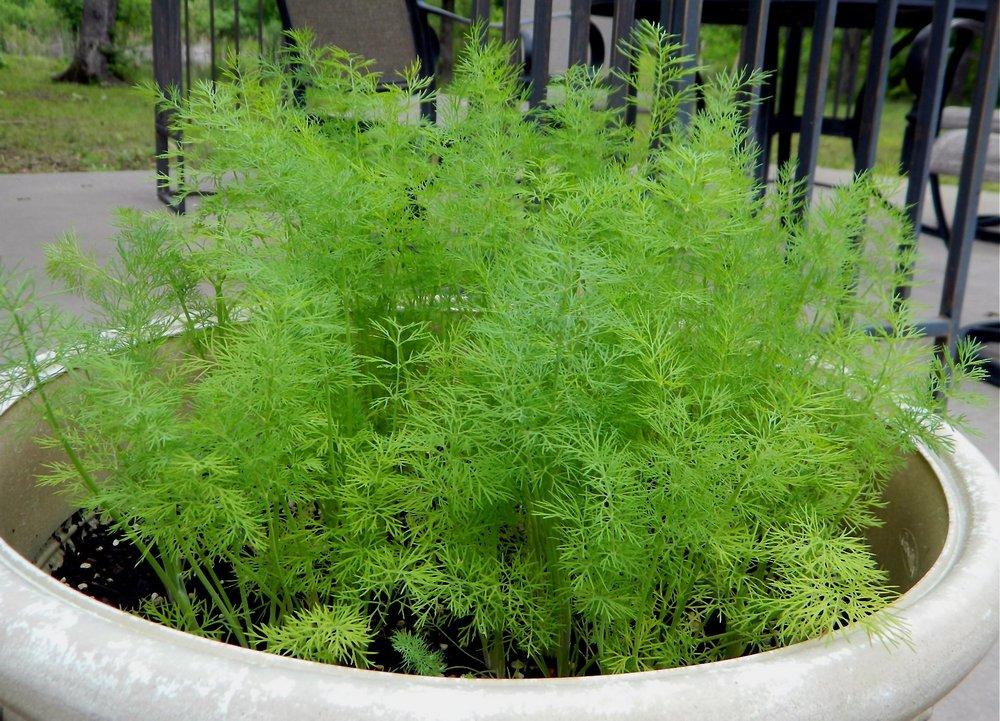Pickles, salad dressing, seafood, potatoes, and cucumbers: these are just a few of dill's culinary dance partners, making it a favorite in the herb garden. It's flavor is never better than when you pick it fresh from your garden. Another good reason to grow this graceful plant: The umbel of delicate yellow-green flowers attracts beneficial insects, from pest-eating wasps to colorful butterflies.

Common dill grows to a height of about 3 feet; bouquet dill is a smaller variety that generally produces fewer blossoms and seeds. Dill produces a strong taproot like its cousin the carrot, and so does poorly when transplanted. Instead sow seed right in the garden. Plants thrive in rich, loose soil and full sun location. If you hope to harvest seed at pickling time, plant 1 to 2 weeks before the last spring frost date. In plots that receive less than 6 hours of direct sun per day, grow stocky varieties, such as 'Delikat' or 'Fernleaf'.
Sow Seed 1/4 inch deep in rows 18 to 24 inches apart or broadcast over a bed 2 feet square and gently rake the seeds into the soil. Plants should emerge in 10 to 14 days; let them grow for 10 to 14 more days and then thin them to 12 to 18 inches apart. Make small sowings a few weeks apart until midsummer to get a season-long supply of fresh leaves.
If your garden is in a windy spot, stake the tall plants to prevent wind damage, or grow a dwarf variety. If you let a few plants mature and drop seed, and leave the area undisturbed, seedlings will emerge the following growing season.
Dill in home gardens rarely has pest or disease problems, but black swallowtail butterfly larvae depend on dill as a food source. If they show up in your garden, you can concentrate the caterpillars on a few plants, and reap a double bounty — dill and butterflies!
Harvest and Storage
You can start harvesting the fern-like leaves about 8 weeks after planting. Just pinch off the outer leaves close to the stem. They are most flavorful just when flower heads are opening.
Spread leaves on a screen in a cool, dark place to dry. If you freeze the dried leaves in plastic bags with the air pressed out, they will retain their flavor better.
To harvest seed for pickling, cut off the seedheads when they're light brown, dry them for a few days in paper bags with air holes in the sides, then shake seeds loose in the bag. To separate the seed from the chaff, spread a sheet out on the grass, set a portable fan at one edge of the sheet facing the center, and turn it to "low". Pour the collected seed in front of the fan's breeze, and it will blow away the light chaff, allowing the heavier seed to collect on the sheet below. Store dill seed as you would dried leaves.
 Victory Seed Company has all the seeds you want for your best garden in 2024.
Victory Seed Company has all the seeds you want for your best garden in 2024.
For 25 years, the family-owned Victory Seed Company has provided the highest quality vegetable, herb and flower seeds to families across the country. We are passionate about providing you the best seeds available that give excellent germination, robust plants, and the harvest you want. With a catalog of over a thousand varieties, we have everything, and our prices are the kinds that we'd want to pay. We have hundreds of yesterday's heirloom vegetables, as well as today's award winning hybrid selections. Get to know us by visiting our website and browsing through our online vegetable seed catalog.
| 1. Growing Basil |
| 2. Growing Dill ← you're on this article right now |
| 3. Growing Sage |
| 4. Growing Parsley |
| 5. Basil Varieties |
| 1. Growing Basil |
| 2. Growing Dill ← you're on this article right now |
| 3. Growing Sage |
| 4. Growing Parsley |
| 5. Basil Varieties |